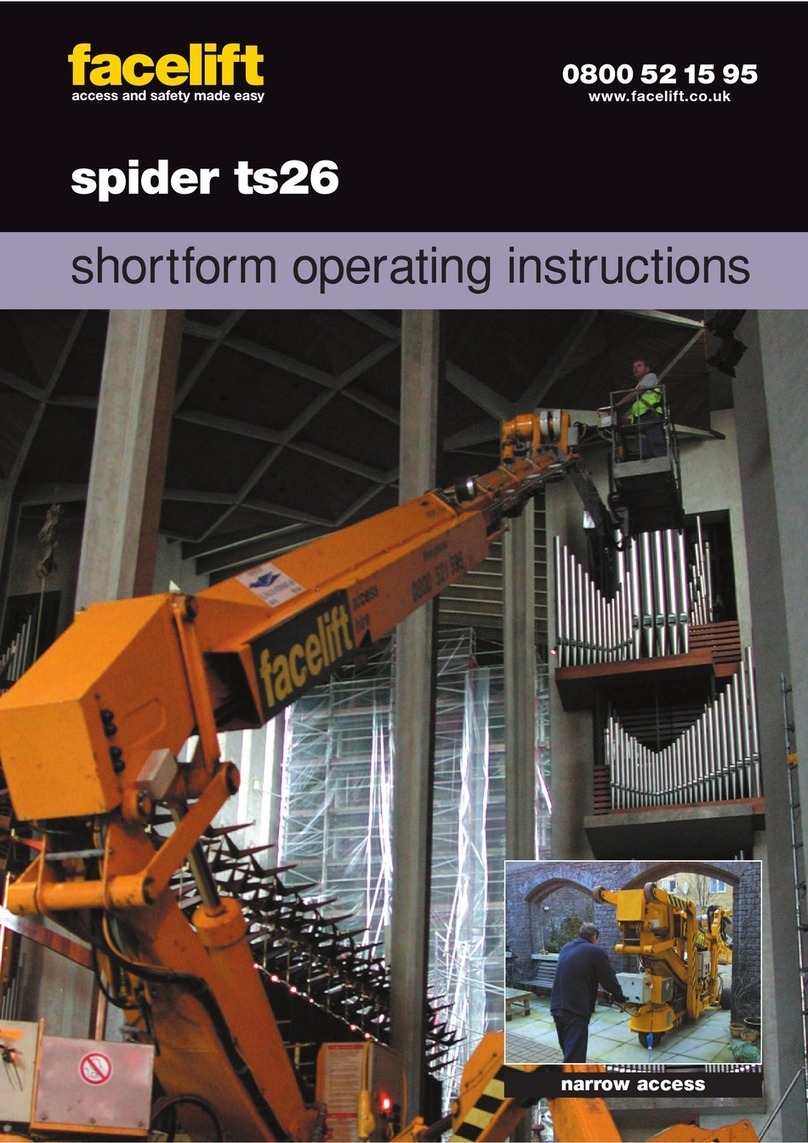1
DAILY SAFETY CHECK LIST
Before use each day and at the beginning of each shift the aerial
platform shall be given a visual inspection and functional test
including, but not limited to, the following:
1) Read and fully understand Operating and Safety Manual.
2) Check safety belts and hard hats.
3) Check all decals and placards to see if in place and legible.
4) Check platform is securely fastened to platform support.
5) Check wheels and tyres.
6) Check outriggers (if applicable) for condition, microswitch
operation and security.
7) Check batteries for condition, cleanliness, connections and
electrolyte levels.
8) Check engine oil, fuel and coolant levels (if applicable).
9) Check installation of all guards, covers and boom clamps.
10) Check for loose, missing or damaged parts.
11) Check all hydraulic hoses and electrical cables and wiring.
12) Check hydraulic, fuel and air systems for leaks.
13) Do not exceed rated platform capacity 440 lbs (200kgs).
14) Check foot pedal for proper operation (if applicable).
15) Check all operating emergency controls – Select an area
free from obstructions and hazards. Exercise extreme
caution throughout the checking procedure especially when
checking brakes
16) Check operation of emergency system and jack recovery
17) Check brakes and all lights.
18) Check tilt sensor/alarm horn and beacons (if fitted).
19) Check high engine and/or high drive limit switches.
20) Check and refer to Operating and Safety Manual for further
daily/periodic checks and inspections.
SETTING UP PROCEDURES
FAILURE TO DEPLOY THE OUTRIGGERS CORRECTLY
COULD RESULT IN DEATH OR SERIOUS INJURY.
ALL MODELS
1) Read and fully comply with all safety precautions and
operating instructions in the Operating and Safety manual
and the warning decals on the machine.
2) Position Niftylift on firm, level ground. NEVER work with
base across or adjacent to any slope.
3) Position Niftylift, bearing in mind range of boom movement
so that any overhead obstruction or possible hazards such
as, but not limited to, power cables, telephone lines, drains,
man-hole covers, etc.
4) If the load bearing capacity of the ground is in any doubt
the machine must not be used.
5) Check wheels and cordon off area using appropriate
cones, barriers and flags.
6) Release boom travelling clamp.
7) Check all red emergency stops are not engaged i.e. fully out.
8) Ensure selector handvalve adjacent to ground control
station is turned fully down to outrigger/drive position.(for
four wheel drive machine grasp and hold duty selector.
Power will be available automatically).
9) From the cage control station depress and hold the green
power button or footswitch to give hydraulic power to the
outriggers and select the appropriate control lever. Note: No
power will be available if the booms are not in the boom rest.
10) Using the four outrigger control levers, (toggle switches on
4WD), lower each outrigger onto a firm level surface and
level machine base ensuring each outrigger foot is taking
equal weight with the wheels clear of the ground.
11) Check machine is level using spirit level on the base, visible
from the cage.
12) Change selector valve at drive/outrigger control station to
platform, i.e. turn fully up. (On four wheel drive machines
releasing the duty selector handle automatically returns the
machine to ‘platform’ operation).
13) The booms can now be operated from the ground or cage
control station by depressing and holding the green power
button. Note: If no power is available check each outrigger
is lowered and each footpad is taking weight.
14) Always lower booms before adjusting, raising, retracting or
moving outriggers in any way.
15) Never alter, modify or block any of the safety circuits on
the Niftylift.
GROUND CONTROL OPERATION
ALWAYS ALLOW THE ENGINE TO
WARM UP BEFORE OPERATING.
ALL MODELS
1) Ensure all red emergency stops are out.
2) Turn key switch at ground control station to ground (i.e.
fully down).
3) Ensure selector hand valve (if applicable) is turned to
platform position i.e. fully up.
4) Battery electric models go to step 10).
DIESEL ENGINE OR BI ENERGY MODELS
5) Turn duty selector in platform to BATT (Battery) or
ENG (Engine).
6) If BATT (Battery) is selected go to step 10).
7) If ENG (Engine) is selected go to step 8). for a COLD
ENGINE or step 9). for a WARM ENGINE.
8) COLD ENGINE. turn the main engine ignition switch (located
in RHS engine canopy) through ON to GL. This engages the
glow plug pre-heat system. Hold for 3-5 seconds then turn
key fully to ST (start) position and the engine will fire.


























